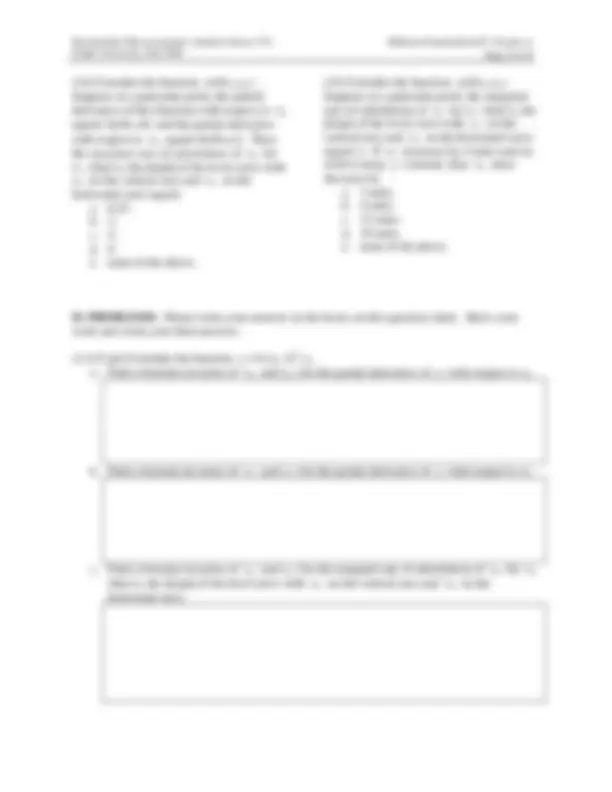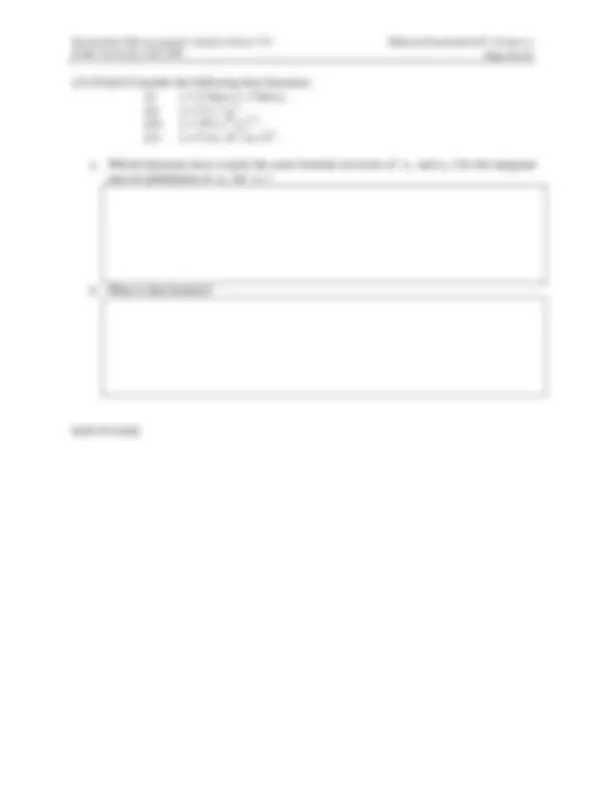




Study with the several resources on Docsity

Earn points by helping other students or get them with a premium plan


Prepare for your exams
Study with the several resources on Docsity

Earn points to download
Earn points by helping other students or get them with a premium plan
Community
Ask the community for help and clear up your study doubts
Discover the best universities in your country according to Docsity users
Free resources
Download our free guides on studying techniques, anxiety management strategies, and thesis advice from Docsity tutors
A midterm exam for the intermediate microeconomic analysis course offered at drake university in the fall of 2001. The exam consists of multiple choice and problems sections, covering topics such as derivatives, elasticity, and partial derivatives. Students are not allowed to use calculators or notes during the exam.
Typology: Exams
1 / 4

This page cannot be seen from the preview
Don't miss anything!



Intermediate Microeconomic Analysis Signature: (Econ 173) Printed name: Drake University, Fall 2001 William M. Boal ID number:
MIDTERM EXAMINATION #1 VERSION A “Mathematical Tools” September 10, 2001
INSTRUCTIONS: This exam is closed-book, closed-notes, and calculators are NOT permitted. Point values for each question are noted in brackets. As usual in this course, “exp(x)” denotes the exponential function (ex) while “ln(x)” denotes the natural logarithm function (logarithm to base e).
I. MULTIPLE CHOICE: Choose the one best answer to each question and mark it on the SCANTRON sheet. Use this question sheet for scratch work. [5 pts each—75 pts total]
(1) Suppose the derivative of the function y=f(x) equals -3 at a particular value of x. At that point, the graph of the function is a. upward-sloping. b. downward-sloping. c. vertical. d. horizontal. e. cannot be determined from the information given.
(2) Suppose the derivative of the function y=f(x) equals 8 at a particular value of x. If x increases by 0.2, then y will increase by approximately a. 0.. b. 1.. c. 1.. d. 8.. e. none of the above.
(3) Suppose y = 5 + (2/x). Then the derivative of y with respect to x is given by the formula a. dy/dx = 2. b. dy/dx = -2/x 2. c. dy/dx = 2/x 2. d. dy/dx = 5x. e. none of the above.
(4) Consider the following functional forms, where a, b, and c denote constants. Which form has constant slope (or derivative)? a. y = a + b x. b. y = a + b x + c x 2. c. y = a x b^. d. y = exp (x). e. none of the above.
(5) Suppose y = x 2 – 16x + 100 , where x must be nonnegative. The minimum value of y occurs where x equals a. 0. b. 2. c. 8. d. 16. e. none of the above.
(6) Suppose y = -x 2 - 6x + 100 , where x must be nonnegative. The maximum value of y occurs where x equals a. 0. b. 2. c. 3. d. -. e. none of the above.
Drake University, Fall 2001 Page 2 of 4
(7) Suppose the elasticity of the function y=f(x) equals 0.6 at a particular value of x. If x increases by 5%, then y will increase by approximately a. 0.6 %. b. 3.0 %. c. 5.0 %. d. 5.6 %. e. none of the above.
(8) Consider the following functional forms, where a, b, and c denote constants. Which form has constant elasticity? a. y = a + b x. b. y = a + bx + cx 2. c. y = a x b^. d. y = exp (x). e. none of the above.
(9) Consider the function y=f(x 1 ,x 2 ). Suppose at a particular point, the partial derivative of this function with respect to x (^1) equals ∂y/∂x 1 =3, and the partial derivative with respect to x 2 equals ∂y/∂x 2 =-1. If x (^1) increases by 0.4 and simultaneously x (^2) increases by 0.3 , then y will increase by approximately a. 0.. b. 0.. c. 0.. d. 0.. e. none of the above.
(10) Suppose y = 4 x 13 x 25. Then the partial derivative of y with respect to x 1 is given by the formula a. ∂y/∂x 1 = 12 x 12. b. ∂y/∂x 1 = 4 x 25. c. ∂y/∂x 1 = 3 x 12 + 5 x 24. d. ∂y/∂x 1 = 12 x 12 x 25. e. none of the above.
(11) Consider the following functional forms, where a, b, c, d, and e denote constants. Which form has constant partial derivatives (∂y/∂x 1 and ∂y/∂x 2 )? a. y = a + b x 1 + c x 2. b. y = ax 1 + bx 2 + c (x 1 x 2 )1/^. c. y = a x 1 b^ x 2 c^. d. y = a (x 1 -b)c^ (x 2 -d)e^. e. none of the above.
(12) Consider the function y=f(x 1 ,x 2 ). Suppose at a particular point, the partial elasticity of this function with respect to x (^1) equals 2, and the partial elasticity with respect to x 2 equals 1/2. If x 1 increases by 1% and simultaneously x 2 increases by 6% , then y will increase by approximately a. 2.5 %. b. 5.0 %. c. 6.0 %. d. 7.0 %. e. none of the above.
(13) Consider the following functional forms, where a, b, c, d, and e denote constants. Which form has constant partial elasticities? a. y = a + b x 1 + c x 2. b. y = ax 1 + bx 2 + c (x 1 x 2 )1/^. c. y = a x 1 b^ x 2 c^. d. y = a (x 1 -b)c^ (x 2 -d)e^. e. none of the above.
Drake University, Fall 2001 Page 4 of 4
(2) [10 pts] Consider the following four functions. (i) y = 2 ln(x 1 ) + 3 ln(x 2 ). (ii) y = 5 x 12 x 23. (iii) y = 10 x 1 2/5^ x 2 3/^. (iv) y = 5 (x 1 -2)^2 (x 2 -3)^3.
a. Which functions have exactly the same formula (in terms of x 1 and x 2 ) for the marginal rate of substitution of x 2 for x 1?
b. What is that formula?
[end of exam]